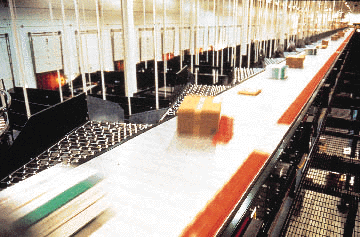Design team members: Greg Cantlon, Joe Philbrook
Supervisor: Phong Hoang S-S Technologies Inc.
Background
As companies continue to look for ways of improving product cycle times, reducing costs, and increasing efficiency, technological improvements are often examined. In the warehousing and logistics industry, companies have been examining control automation and data management integration as potential technological enhancements to conveyor and sortation systems. The material handling industry in the United States alone has grown to $60 billion dollars a year and is expected to continue to grow in the years ahead.
Sortation system control has traditionally rested in the hands of conveyor system manufacturers, especially high-speed conveyors, using embedded proprietary controllers. Of late, an increase in the processing power of both Programmable Logic Controllers (PLCs) and PCs has encouraged new changes to take place in the warehousing automation industry. Conveyor manufacturers and conveyor customers are now turning down embedded proprietary controllers in favour of systems that have a more viable fit and future with their overall manufacturing and inventory systems. Clients want to be able to seamlessly integrate conveyor controls into their human machine interfaces, data trending tools, and warehouse management systems.
Project description
At the heart of SmartControl is the development of package tracking logic for a shoe sortation system. Shoe sorters are typically implemented for high-speed applications capable of running at 80 to 200 sorts/minute. Depending on the average size of the packages, high-speed sort conveyors may run at speeds from 100 to over 600 feet/minute. Package tracking at these speeds offers many unique challenges and control response issues.

Development of the tracking logic will be a PC-based control solution implemented using Rockwell SoftLogix 5 with embedded C functions. The SmartControl will be useful to those wishing to enter the conveyor and sortation controls market, as well as system integrators wishing to reduce one-off development time required for a shoe sorter implementation.
Design methodology
There are 5 stages to the development of the SmartControlä tracking logic.
Market Research Study - The market research study investigates the dynamics and trends in the sortation controller market and evaluated the feasibility of SmartControlä . This justifies the need for SmartControlä . Specific areas of interest include current trends in the conveyor and warehousing industry, current sort control suppliers and available control platform vendors. Market research will also examine the types and capabilities of various modern sortation systems.
Product Design Specification - The product design specification encompassing all aspects of the SmartControlä project from understanding the system environment to constraints and criteria for the system. Developing a PDS aids in defining requirements for developing and/or selecting individual system components.
Implementation Platform Evaluation - This evaluation resulted in Rockwell SoftLogix 5, as the development platform of choice. From the numerous software platforms available each alternative is weighed against various design requirements. A comparison matrix is developed to aid in evaluating the alternatives. The platform that best meets the specifications and customer preferences is selected.
Shoe Sorter Properties - To develop the controls for a shoe sorter, the operation and design requirements of a shoe sorter are fully investigated. Various methods of determining package location and special communication requirements to integrate the sorter with other sections of the conveyor system and business logistic applications are considered.
Development - The tracking logic is implemented and tested on the selected control platform. This stage includes coding the algorithm and developing a simulation and user interface for feedback and testing.
Continuous Improvement - The design process is a continuous cycle. At any stage of the design process, it may be required to revisit previous steps, look ahead at future steps or iterate over a number of steps to ensure that all design constraints have been satisfied.
